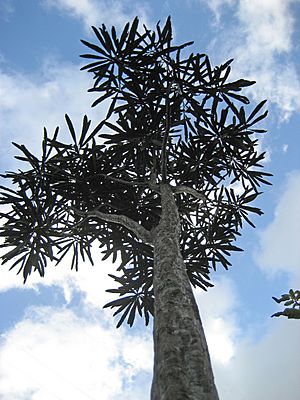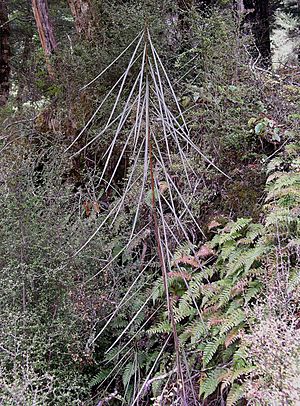Horoeka facts for kids
Quick facts for kids Horoeka |
|
|---|---|
 |
|
| Adult tree | |
| Scientific classification | |
| Genus: |
Pseudopanax
|
| Species: |
crassifolius
|
The horoeka or lancewood (scientific name: Pseudopanax crassifolius) is a unique tree from New Zealand. It belongs to the plant family Araliaceae. You can find it all over New Zealand, from the coast up to about 750 meters high.
What makes the lancewood special is how much it changes as it grows. For the first 15 to 20 years, it looks very different from an adult tree!
Contents
A Tree That Changes Its Look
When the lancewood is young, its leaves are stiff and feel like leather. They have a strong central line and can be up to 1 meter long. These long, narrow leaves have jagged teeth that point downwards. The young tree's trunk also has interesting swollen ridges that run vertically.
As the lancewood gets older, it starts to change. The single stem begins to grow branches, forming a bushy top. Its leaves become wider and shorter, and they lose their jagged teeth. Only when the tree is fully grown does it look like a typical tree with a rounded top.
The Moa Theory: Why the Change?
Scientists have a cool idea about why the young lancewood looks so different. This idea is called the "moa theory." Long ago, giant flightless birds called moa roamed New Zealand. These huge birds ate plants.
The theory suggests that the young lancewood's strange shape and tough, spiky leaves helped protect it from being eaten by moa. The downward-pointing teeth and stiff leaves might have made it difficult for the moa to browse. Once the tree grew tall enough to be out of reach of the moa, it no longer needed these defenses. That's when it could change into a "regular" tree shape.
Scientists studied a similar tree on the Chatham Islands. This island never had moa. Interestingly, this related tree did not show the same dramatic changes in its leaves as it grew. This supports the idea that the moa played a role in the lancewood's evolution.
Lancewood's Relatives
The Pseudopanax crassifolius has a close relative called Pseudopanax ferox, or the toothed lancewood. It looks a lot like the P. crassifolius. However, the P. ferox has even more leaves, and their teeth are much sharper and more noticeable. They can look a bit like the blade of a bandsaw.
See also
 In Spanish: Pseudopanax crassifolius para niños
In Spanish: Pseudopanax crassifolius para niños


